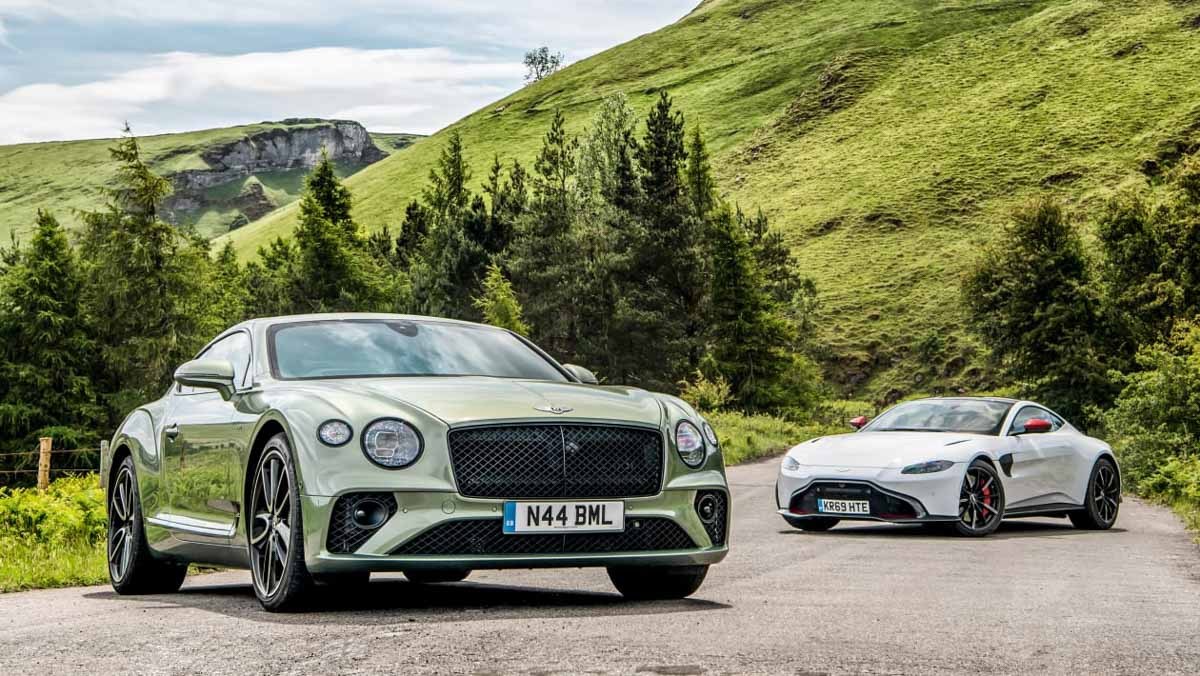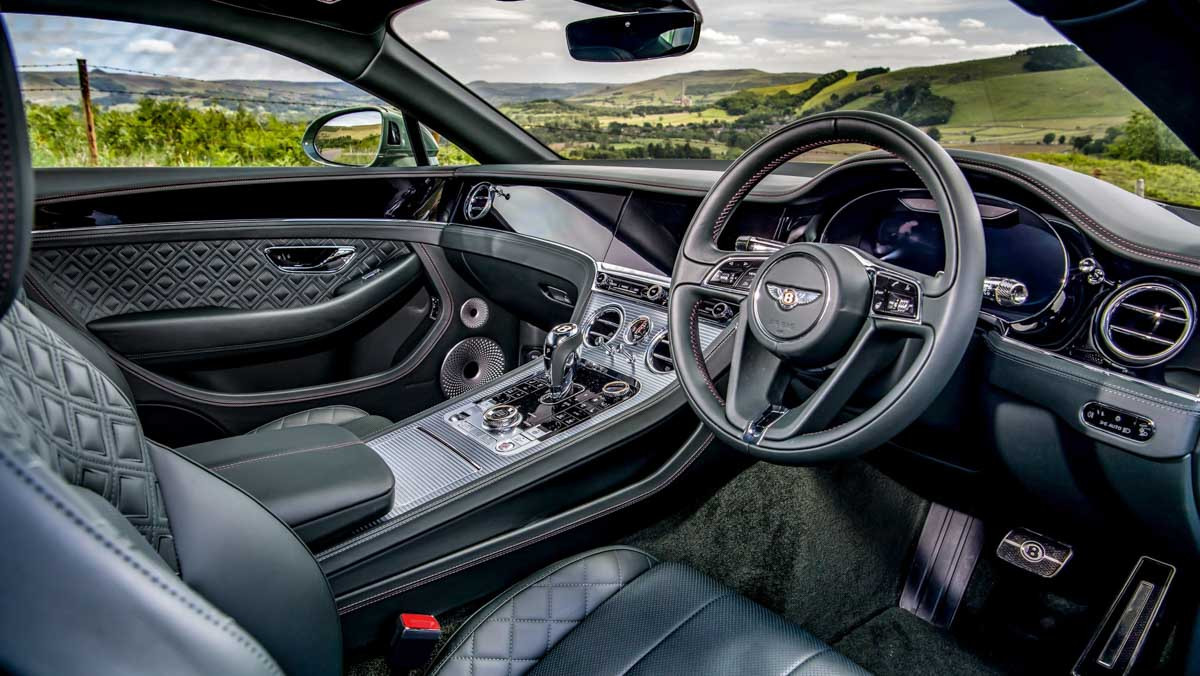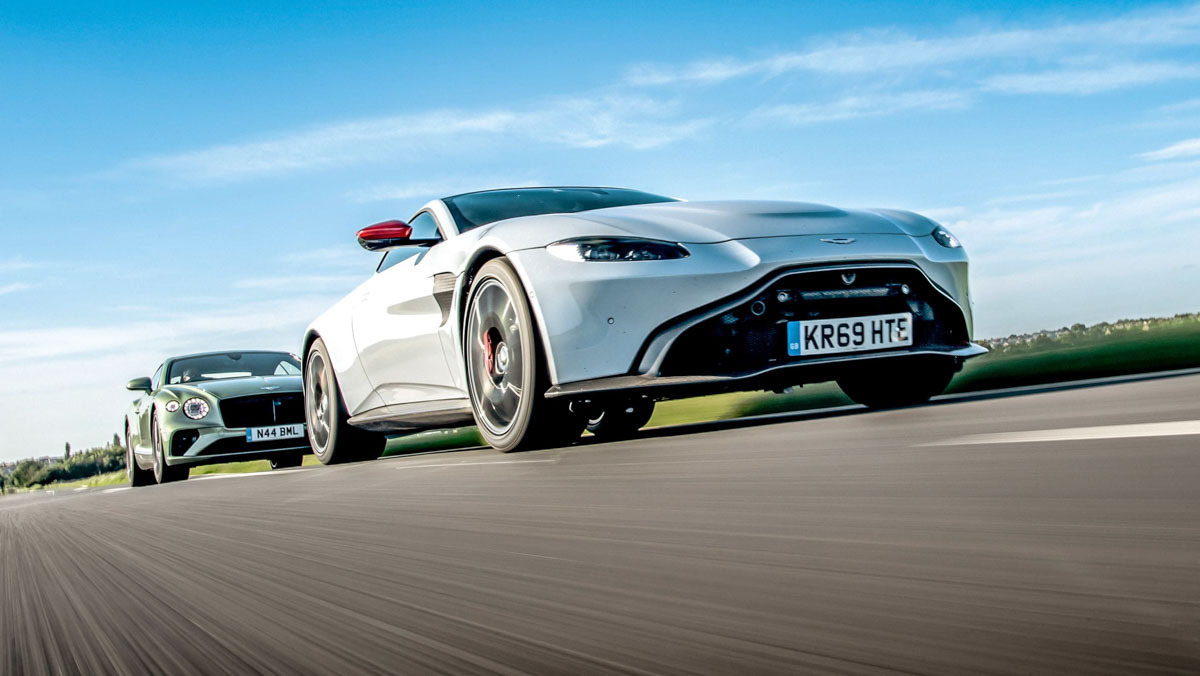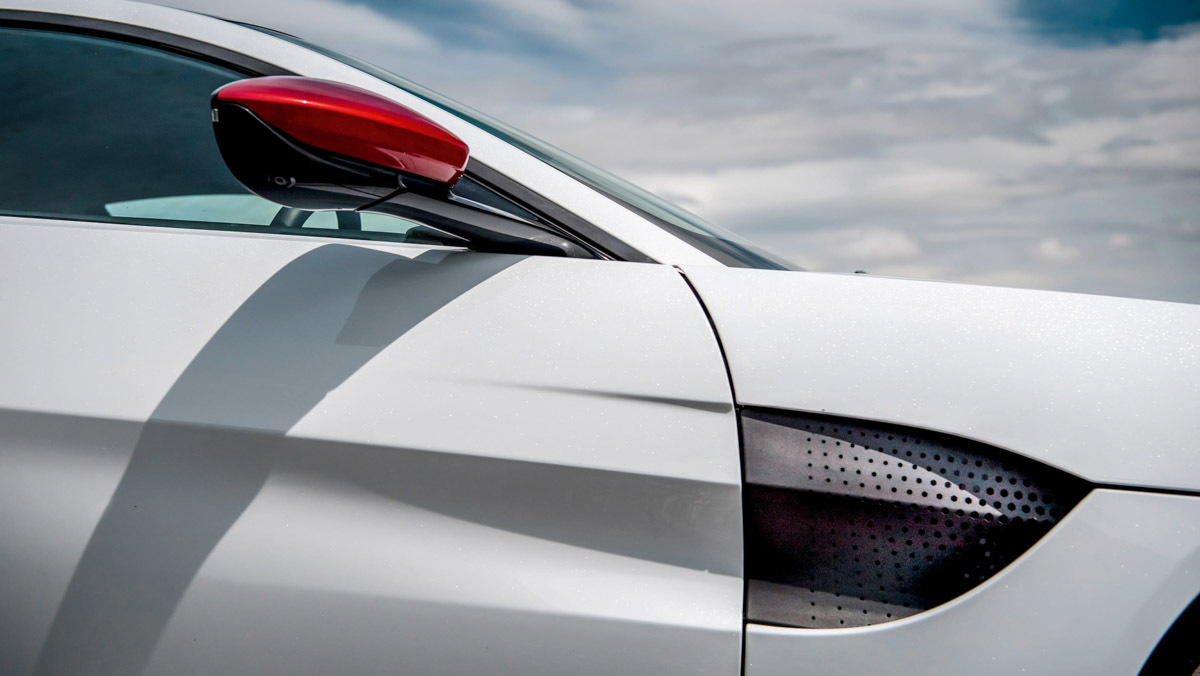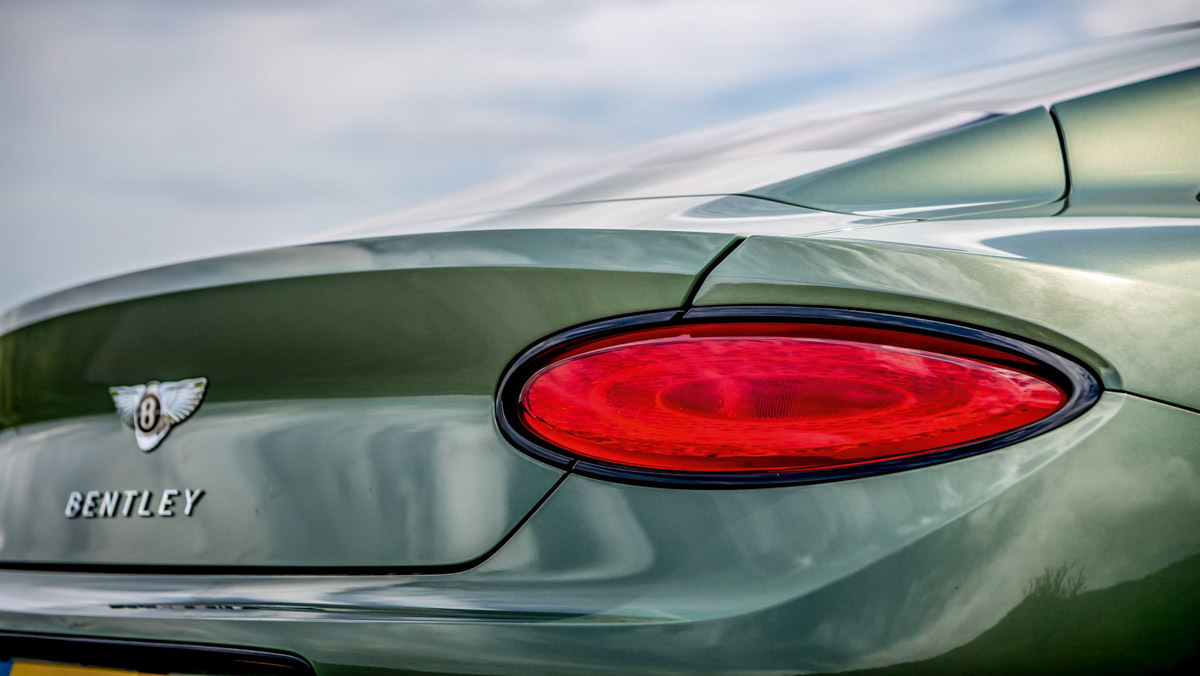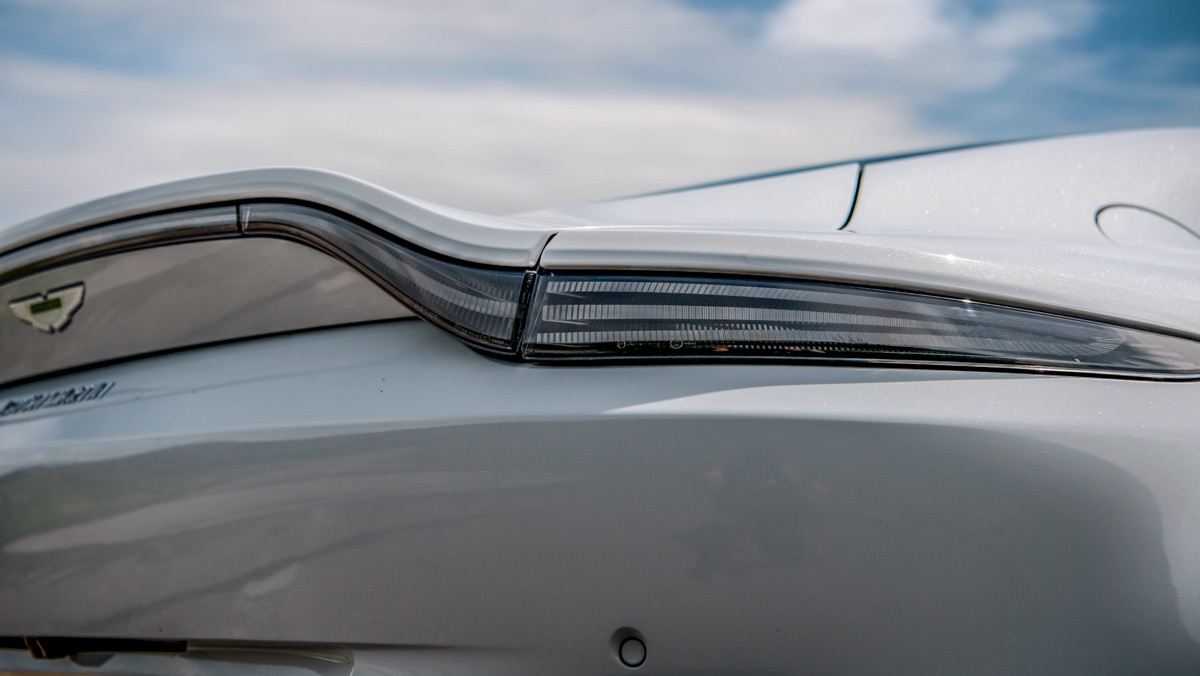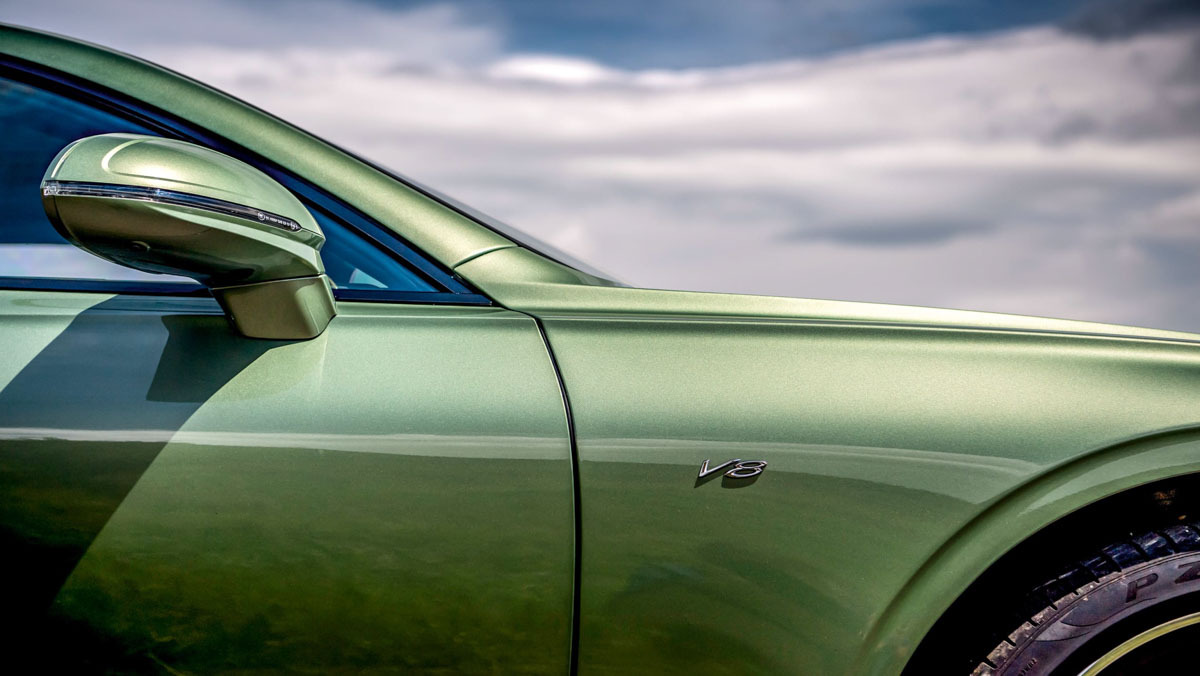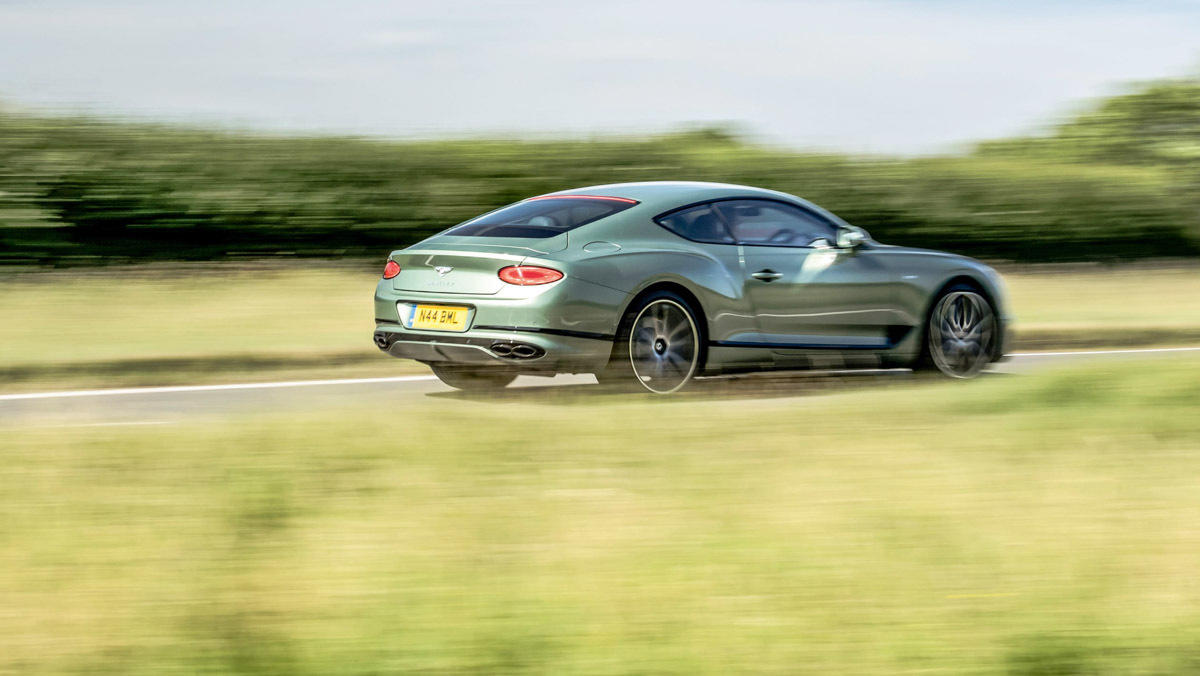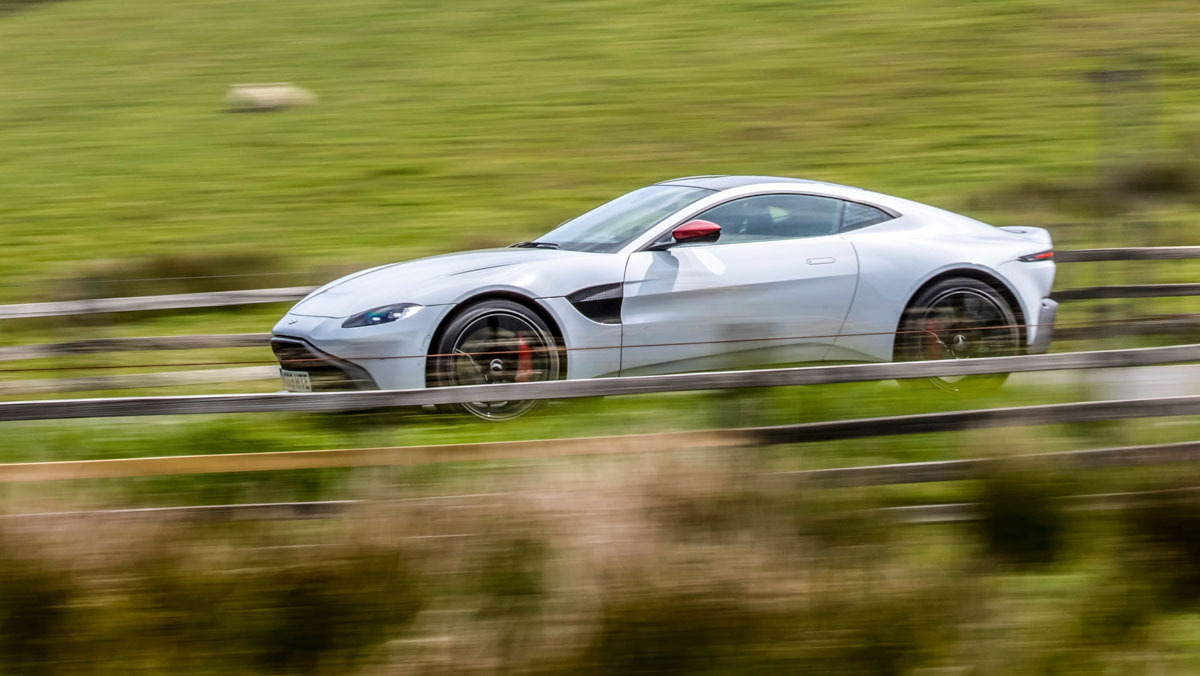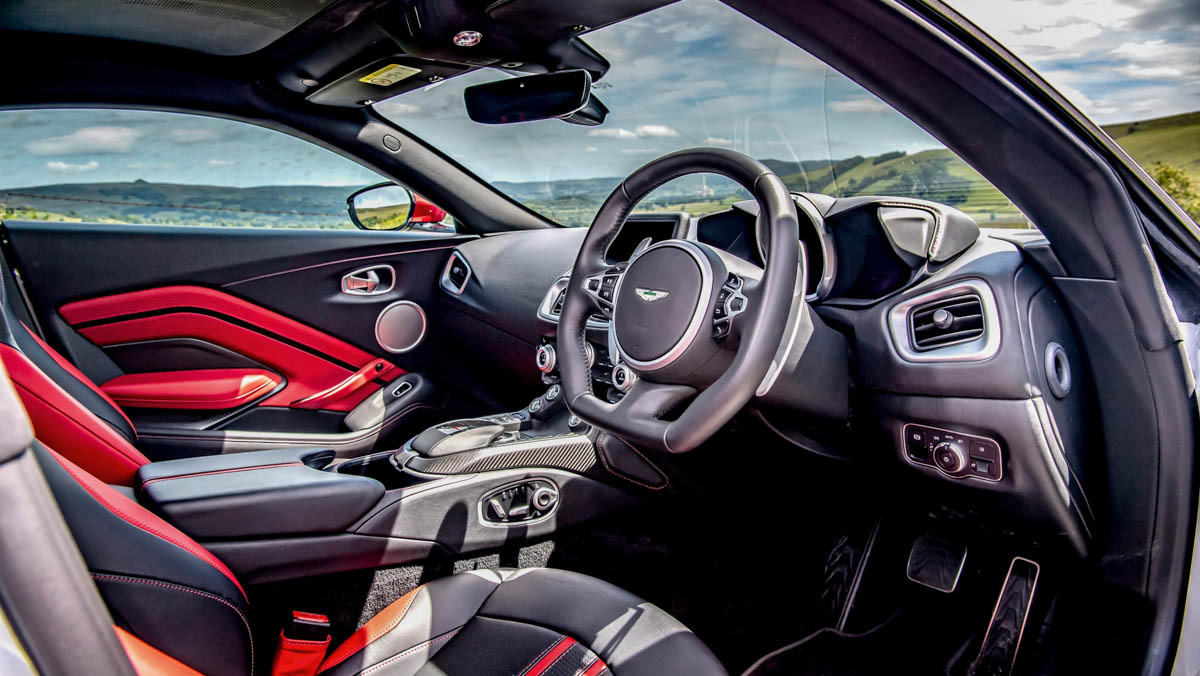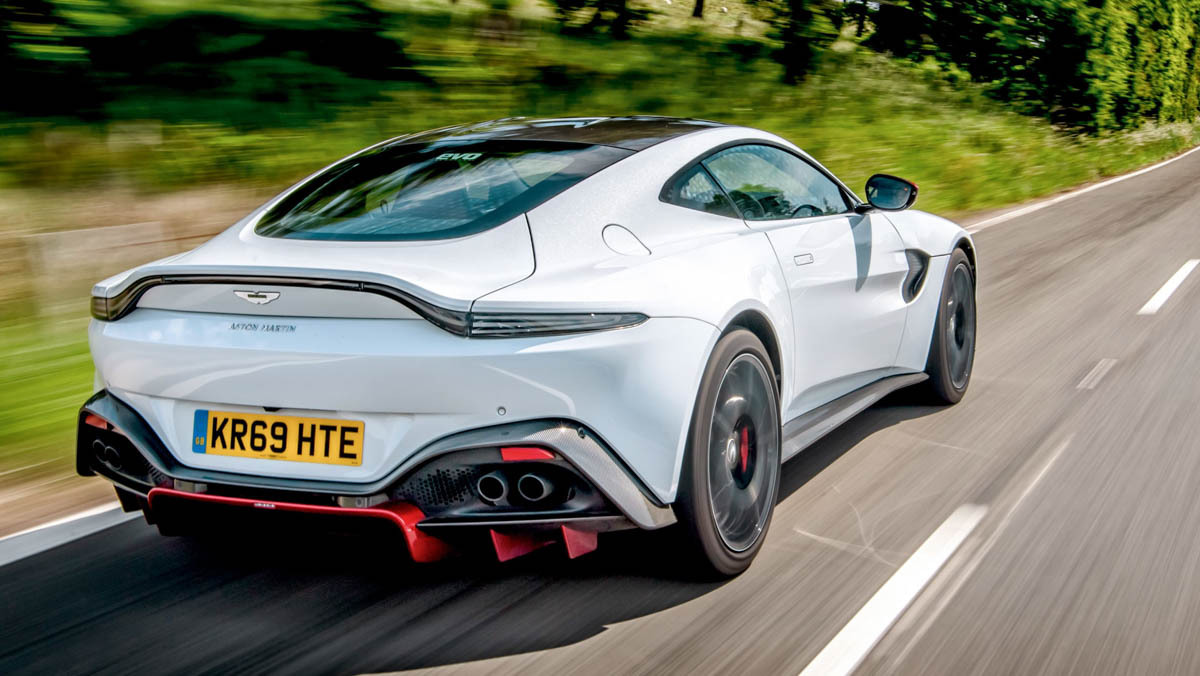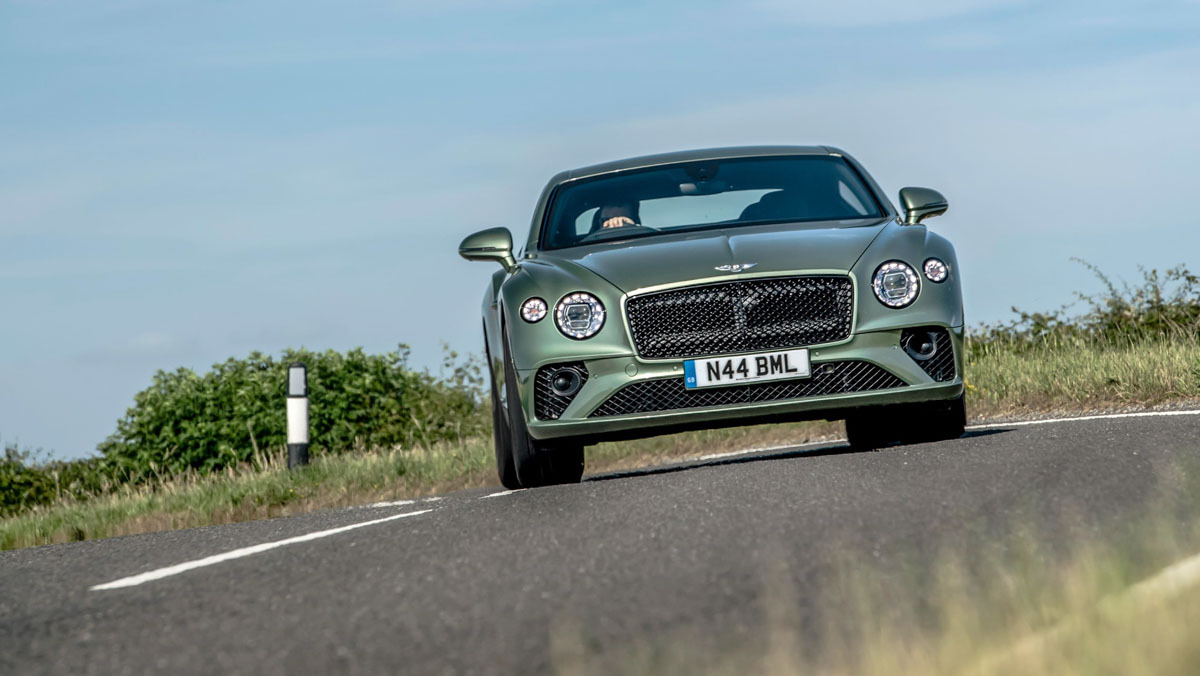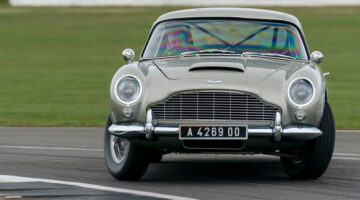The latest Bentley Continental GT V8 and Aston Martin Vantage offer two different takes on the front-engined supercoupe formula. But which should you choose?
These are entry level models. The first rungs of Aston Martin and Bentley’s respective ranges. While you let that sink in for a moment, let’s pause to ponder their objectives, specifications and vital statistics.
Superficially these are two very similar cars. Both the product of storied British brands (OK, British so long as you ignore the mix of German, Middle Eastern and Canadian ownership…), each boasts a 500-plus bhp 4-litre, twin-turbocharged V8 engine mated to an eight-speed torque-converter automatic transmission. Likewise, each promises to be the sportiest and purest driver’s car in their marque’s model portfolio.
Scratch deeper beneath the surface, however, and the differences in approach are more significant than the similarities in brand and hardware, the Continental GT V8 being a luxurious all-wheel-drive 2+2, while the Vantage is a resolute rear-wheel-drive machine strictly tailored for two.
> Bentley Bacalar 2021 review – Crewe’s answer to Ferrari’s FXX programme
All-out each gets tantalisingly close to 322kph, though the Aston is quicker to 100kph, hitting the benchmark time in 3.6sec versus 4.0 dead for the considerably heftier, 2165kg Bentley.
Ignoring any dealer discounts that might be floating around, the Aston starts at $173k with the auto ’box (as here), while the better-equipped Bentley begins just beyond $210k. Typical options will realistically add a further $35k or so to each. They may be the babies of the range, but both are very grown-up purchases.
Such divergent approaches to building supremely potent, prestigious and desirable coupes make these compelling cars to compare. In so doing we’ll get to the heart of what separates each brand and zero in on what that means in terms of driving dynamics and owner appeal.
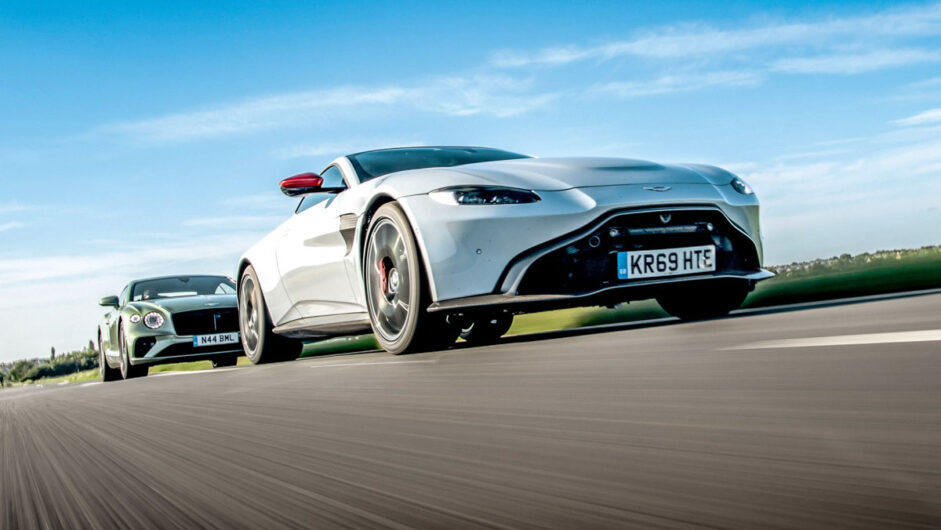
Shunning alphabetical convention we’ll start with the Bentley. The latest-gen Conti GT has proportions and features familiar from the original, but the shape is so much more defined. It has evolved from something rather amorphous to something truly sculptural. It expresses a true sense of speed through a dramatically streamlined shape – one never better expressed than in the sharp lines that form at the headlights and flow all the way down the flanks of the car. Even the headlights themselves are extraordinary things, with jewellery-like facets that mimic a piece of cut glass.
This car’s mid-green exterior and dark green interior may sound like the car equivalent of a verdant double denim, but it works exceptionally well. The quality of the leather and the stitching is first rate, though the design is quite blingy. Especially in combination with the high-gloss surfaces and chrome switches. It may not be to all tastes, but there’s no question it has the quality to carry it off, largely thanks to Bentley’s production department being prepared to sign off large amounts of budget to make sure everything looks and feels of the highest possible quality.
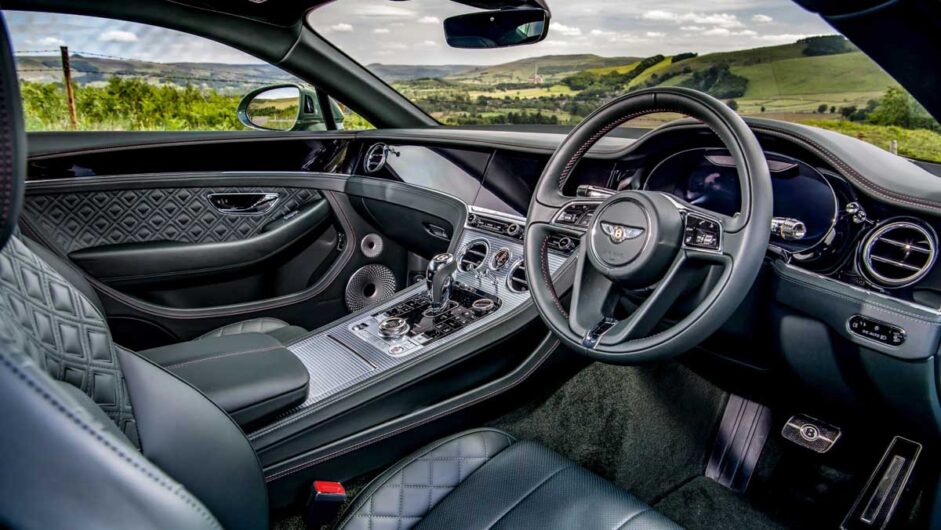
The Aston is much more overt in its exterior styling. It’s undeniably and deliberately divisive. In fact you could say it’s the apex of Aston’s reaction against those who complained about the previous-generation Vantage, DB9, DBS and Rapide being Russian dolls. Beautiful ones, admittedly, but all sharing the same features.
The busy, aggressive approach continues inside, with dozens of switches and heavily hooded instruments. You sit low, so there’s an exaggerated cockpit-type feel, but it all just seems to try a bit too hard. Worse, compared to the Bentley it all feels rather flimsy and lacking in substance. The Conti’s quality comes at a price in terms of weight, but unfortunately the lasting impression of the Vantage’s rather brittle interior is one of cost saving, not weight saving. It’s also well off the pace in terms of infotainment.
The flip side comes when you begin to drive. Even judged in isolation the Vantage is truly intense. Push the starter button and it immediately pulses with energy from that AMG-sourced, AML-tweaked V8. It’s got some teeth, no doubt about it. You feel in close proximity to the heart of the car and the moving components that give it life and vibrancy. The Bentley is by definition a more discreet character. It starts with a promising, pulsating soundtrack, but after clearing its throat for theatrical effect the engine quickly fades into the background, felt but not heard.
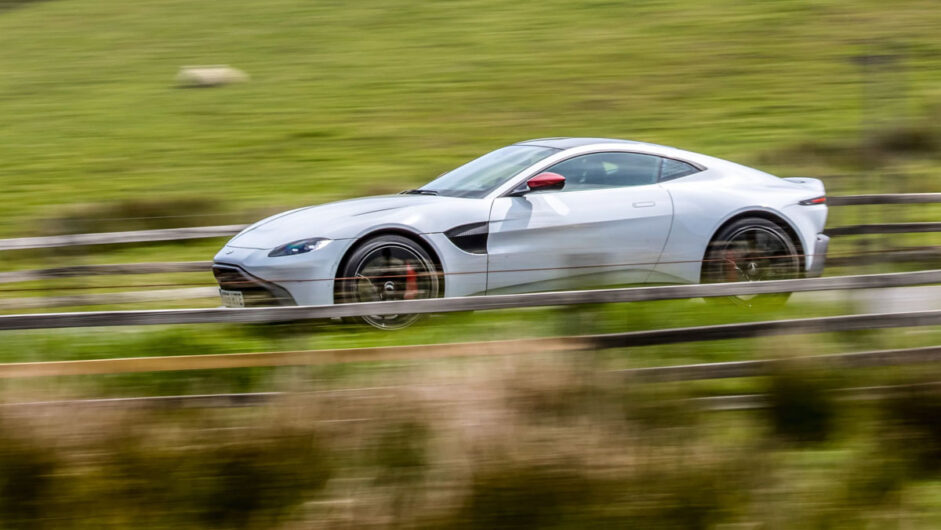
These first impressions extend into the wider driving experience, the Aston feeling much more exciting from the off. It connects you to everything, and because there’s more energy in the car you immediately put more energy into your driving. I only use the Bentley’s paddleshift very occasionally, and largely because I feel I ought to for the purposes of the test, but it feels much more natural to use the Aston’s paddles, as you’re keen to put your stamp on how you make progress.
It might be a basic measure, but to me this desire to roll up your sleeves is a litmus test of how engaged you feel in the process of making progress. Advantage Vantage, then.
It’s no great surprise, for Aston pursued a deliberately aggressive course with this car, the need for each model’s styling and dynamic behaviour to be reflections of one another being the mantra within Aston for all the Palmer-era cars.
> Bentley Continental GT V8 review – the driver’s Conti GT
Whatever you think of the Vantage’s styling, there’s no denying its dynamic fingerprint is a match for its attacking looks. Everything about the way it moves is amplified, that inherently sporting feel increasing incrementally as you toggle through the dynamic modes. Never less than firmly suspended, it supports itself with iron-fisted resolve, but also offers pliancy in its softer modes.
When the opportunity comes to press on with something approaching full commitment there are times when you need to put some more support into the car. This is delivered nicely in Sport+, which better controls vertical movement, particularly at the rear. This greater sense of being tied-down fosters huge confidence without adding too much tension into the damping, so the car still works with the road. Indeed, unless the surface gets particularly rough you can quite happily stay in Sport+ and not feel like you’re having your teeth rattled. It’s nuanced, not about body control and corner speed at all costs.
The paddleshift transmission is very good, at least by torque-converter standards, but lacks the snap and immediacy of the best double-clutch ’boxes. This said, I’m pretty certain there’s never been a more dynamically focused car fitted with a torque-converter ’box, so the fact it delivers rapid upshifts, crisp throttle-blip downshifts and rarely denies a pull for a lower gear under maximum braking efforts means that, although it’s not the last word in driver engagement, it doesn’t get in the way of your enjoyment.
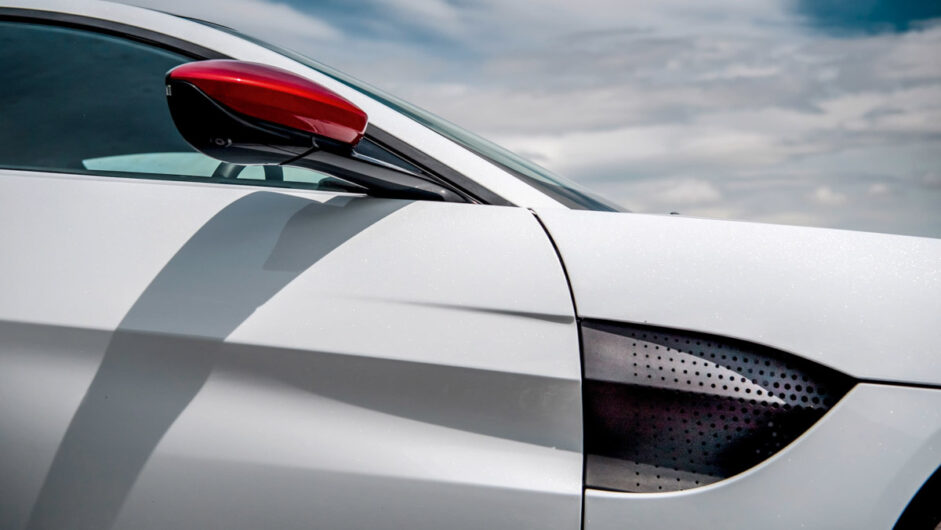
The steering is quick-witted and has a real sense of urgency. You don’t have to make large applications of lock to get the car to dive for an apex, but this means you have to calm your inputs down in order to become at one with the Vantage’s voracious appetite for direction change.
It rotates with real enthusiasm, enough to test your trust that it’s actually got enough grip at the rear to keep pace with the front end’s rate of response. But when that penny drops, wow! You can step up several gears in terms of the commitment you show the car and the manner in which you throw it into a corner. It excels at rapid direction changes, carving through turns like a slalom skier.
Matching the chassis is straight-line performance that has a raw, explosive quality. It perhaps sounds derogatory to suggest the Vantage has a hot-rod quality to the way it punches though the gears, but it’s actually a compliment. That Merc motor may have a brutish quality familiar to AMG customers – something that arguably dilutes Aston’s standalone DNA – but its brute force also has echoes of old-school pre-Gaydon Astons. In short, you wouldn’t want to spill its pint.
> Aston Martin Vantage F1 Edition revealed – new Coupe and Roadster derivitives
Completing the package are the optional carbon-ceramic brakes of our test car (evo’s Fast Fleeter). They’re a little sharp on initial application, but you can compensate quite intuitively, so you rarely have to consciously moderate and modulate your inputs. Once beyond that initial bite point the brakes have terrific stopping power, stamina and feel.
This all combines to create a car that relentlessly eggs you on. Empty roundabouts, open corners, T-junctions, traffic lights – all offer you the opportunity to grab some illicit fun and burn some rubber. You need to have your wits about you if your intention is to provoke a slide, for the breakaway is sharp and requires both swift corrective lock and confident throttle control to achieve more than an edgy stab of oversteer.
It might not conform to Aston’s gentlemanly stereotype, and certainly requires skilled hands to fully exploit and enjoy, but if you place a greater emphasis on dynamism than decorum you’ll find a kindred spirit in the Vantage.
To say making the switch to the Bentley is like chalk and cheese is masterful understatement, for from the moment you grip the steering wheel and squeeze the throttle the difference between them is stark. Chassis-wise the Bentley always feels slightly underdamped. Of course it has a lot of weight to contain, and you certainly don’t want something so stiff it rides like a 2.2-ton skateboard, but still you can sense Bentley’s struggle to find a sweet spot between the car being crashy and wallowy. This said, the current Conti is noticeably more agile and enthusiastic than its predecessor, though the spectre of mass and momentum is always lurking in the shadows.
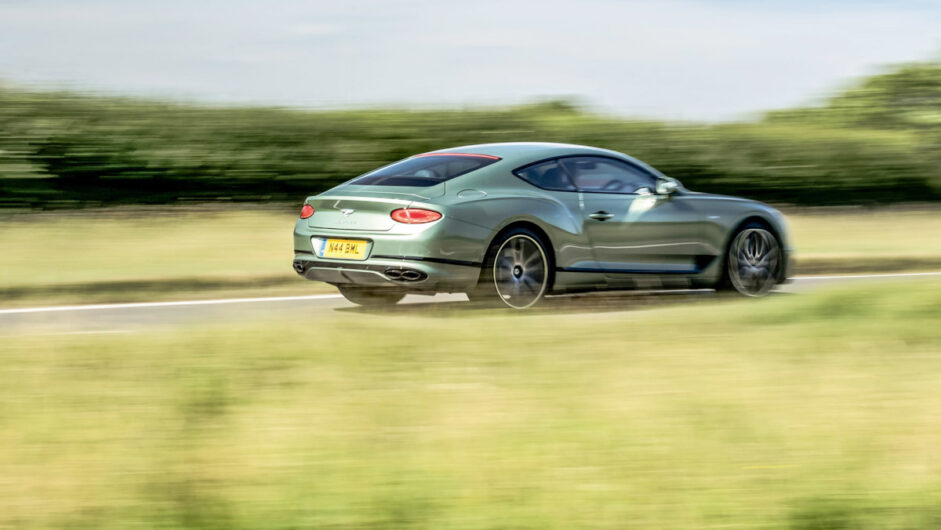
Were you so inclined, and had the room to do so, I’m sure you could switch everything off, lob it into a corner and get the tail to slide, but you would do so in the knowledge such treatment goes against the grain. It is not that car.
What the Conti excels at is putting the full force of its performance down into the road. It has levels and layers of performance that you access almost by accident, because it fosters an inherently less punchy driving style.
Instead of yearning for opportunities to get the thing slicing and slithering through corners, you just build speed and then stay there, enjoying apparently boundless traction and stability, combined with abundant torque and a mighty sense of acceleration. If you enjoy going very quickly with little apparent effort, you’ll find the Conti GT extremely impressive.
It’s inert compared to the Aston’s darty, high-energy style, but make no mistake, when you decide to really give it some, the Conti is monstrously quick across the ground. Its weakness is that compared to the Aston it does feel a bit one-dimensional, because it hasn’t got the ability to meaningfully raise its game beyond that effortless manner of delivery. Perhaps unsurprisingly there’s an Audi RS6 sensation to driving it quickly, albeit while being surrounded by more quality and carrying more mass. Like its VW Group siblings it has an ability to deliver shocking speed, but it does it in a prescriptive manner.
It would be easy to take from all this that the Aston is relentlessly uncouth, but that would sell it short. It’s quite happy to drive in a more relaxed way and simply go with the flow, but compared to the Bentley it’s adrenalised, as though poised on the brink of some kind of fight-or-flight mode. This makes it exciting and provides ready reminders you’re in something with unusual potency. Nevertheless, this energised character compromises the Vantage’s abilities as a GT car. Road noise, wind noise and engine noise are all significantly more intrusive than in the Bentley. Consequently the Vantage is the more selfish choice. Less the car in which you’d embark on a really nice touring holiday with your partner, more the car you’d take for a weekend hoon with your mates.
> Aston Martin Vantage review – can it match the Audi R8 and Porsche 911?
By contrast the Bentley is a soothing and relaxing car, and one that you can also drive bloody quickly without your passengers being aware of quite how fast you’re going. Covert speed rather than overt speed, if you like.
Which would I have? It’s very hard to choose between them, even though they’re totally different cars. In my heart I’m more aligned with the Aston, but I wish it had a bit more of the Bentley’s quality and polish. Then again, I wish the Bentley had a pinch more of the Aston’s attitude and ability. Not just outright dynamic prowess, but its ability to excite at a visceral level.
There’s no question the Bentley is a quality piece, and I’d be lying if I denied that the older I get, the more I’ve come to appreciate cars that will make mighty yet effortless progress. Yet still I know I would feel I was missing out on an essential degree of sporting capability and excitement if I chose Crewe over Gaydon.
In an unexpected way this pair shine a light on the trouble with many of today’s premium performance cars. The Vantage is a car that encourages you to drive quicker and with more commitment than is compatible with today’s roads, yet the Bentley is also quick enough to be too fast to routinely or responsibly unleash on all but the quietest and most remote stretches. Perhaps counterintuitively, because it’s more garrulous in character you get more from the Aston more of the time than the cool, calm and collected Conti GT. As ever, you pays your money and you takes your choice.
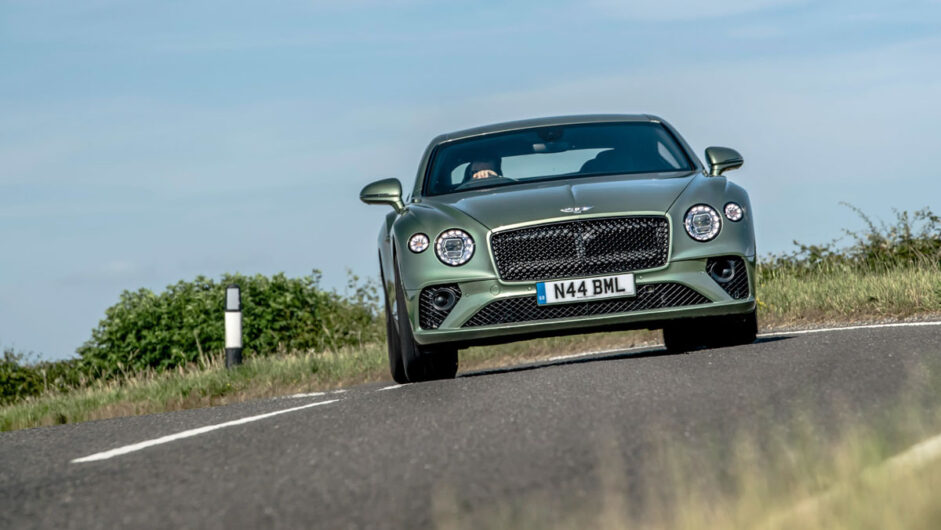
For most people the Bentley is the easier purchase, simply because it’s easier to live with – less extreme and exuding an extraordinary sense of quality, refinement and prestige. If you have the means it would be an absolute pleasure to live with on a daily basis.
The Aston needs the right roads and opportunities to shine brightest, and presents you with greater compromises in those times when you find yourself mired in more humdrum scenarios. What’s undeniable, and what ultimately elevates the Vantage above the Conti GT as a driver’s car, is you always have the promise of those intense moments where, no matter how fleetingly, you and the car can raise your game to access an intense and rarefied zone.
For as long as The Thrill of Driving remains this magazine’s strapline, cars such as the Vantage will always prevail over cars like the Bentley. Even if it is by the narrowest, most focused and most subjective of margins.
Bentley Continental GT V8
| Engine | V8, 3993cc, twin-turbo |
| Power | 542bhp @ 6000rpm |
| Torque | 568lb ft @ 2000-4000rpm |
| Weight | 2165kg |
| Power-to-weight | 254bhp/ton |
| 0-100kph | 4.0sec |
| Top speed | 318kph |
| Basic price | $212,383 |
Aston Martin Vantage
| Engine | V8, 3982cc, twin-turbo |
| Power | 503bhp @ 6000rpm |
| Torque | 505lb ft @ 2000-5000rpm |
| Weight | 1530kg |
| Power-to-weight | 334bhp/ton |
| 0-100kph | 3.6sec |
| Top speed | 314kph |
| Basic price | $174,048 |
This article originally appeared at evo.co.uk
Copyright © evo UK, Dennis Publishing

